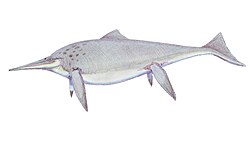| Cymbospondylidae Temporal range: Early Triassic to Late Triassic, | |
|---|---|
 | |
| Cymbospondylus buchseri fossil at the Palaeontological Museum of the University of Zurich | |
| Scientific classification | |
| Kingdom: | Animalia |
| Phylum: | Chordata |
| Class: | Reptilia |
| Superorder: | † Ichthyopterygia |
| Order: | † Ichthyosauria |
| Node: | † Hueneosauria |
| Suborder: | † Longipinnati |
| Family: | † Cymbospondylidae Huene, 1948 |
| Genera | |
| |
Cymbospondylidae is an extinct family of hueneosaurian Ichthyosaurs known from the Middle Triassic of Europe, North America, and Asia. [3] [4]







